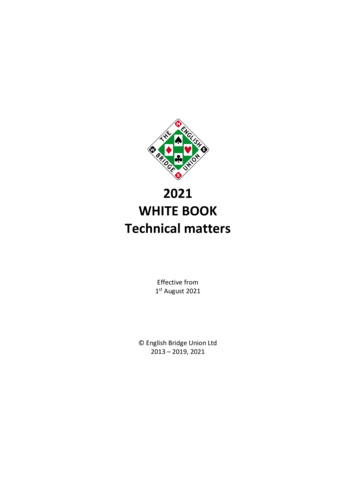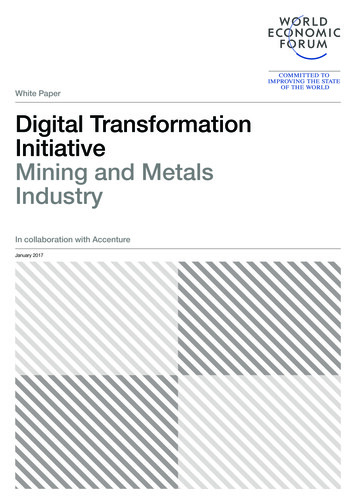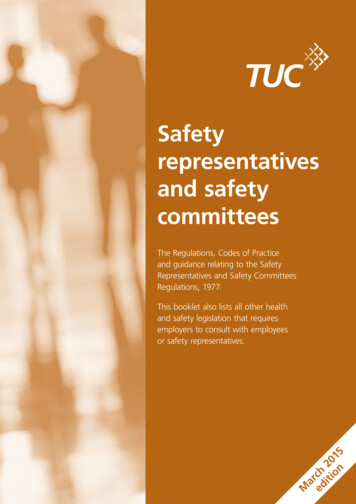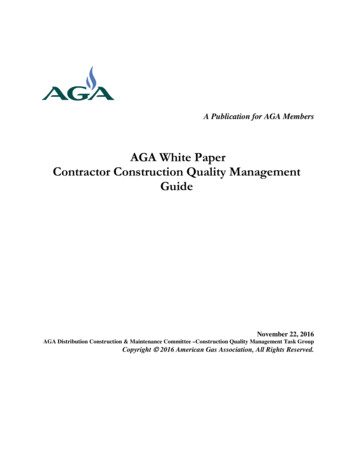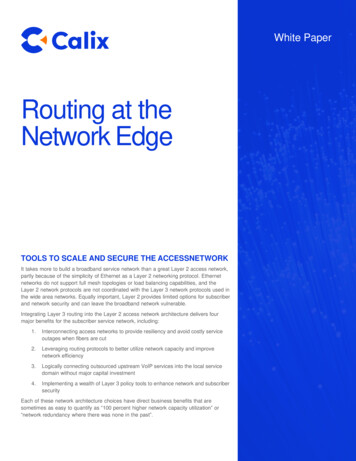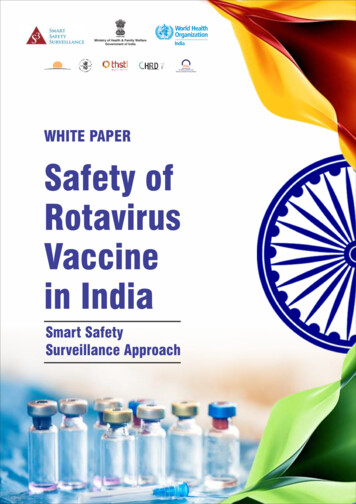
Transcription
WHITE PAPERSafety ofRotavirusVaccinein IndiaSmart SafetySurveillance Approach
WHITE PAPERSafety ofRotavirusVaccinein IndiaSmart SafetySurveillance Approach
Table of ContentsAcknowledgements1Abbrevia ons6Preamble81. Rotavirus and disease112. Rotavirus vaccines122.1. Types of vaccines142.2. Efficacy and usage152.3. Rotavirus Vaccine in Universal Immuniza on Programme of India163. Rotavirus Vaccine safety193.1. Risk of Intussuscep on193.2. WHO recommenda ons on vaccine safety194. Safety surveillance in India214.1. Periodic Safety Update Reports214.2. Adverse Event Following Immuniza on Surveillance214.3. Sen nel Surveillance by CHRD SAS244.4. Sen nel Surveillance by THSTI25Sta s cal analysis4.5. INCLEN Intussuscep on Network Surveillance Study2627Study sites and par cipa ng hospitals27Case defini on, case selec on and data collec on27Quality Assurance285. Findings/ Result295.1. Periodic Safety Update Reports295.2. Adverse Event Following Immuniza on Surveillance295.3. Sen nel Surveillance by CHRD SAS305.4. Sen nel Surveillance by THSTI315.5. INCLEN Intussuscep on Surveillance Network Study34Brief demographics (ages, gender and loca on of IS)34Clinical, management and outcome34Immuniza on exposure status (flowchart)35IS a er rotavirus vaccine exposure356. Discussion377. Annexure40Annexure 140
AcknowledgementsWorking Group Members for White Paper: Dr Gagandeep Kang, Executive Director, Translational Health Science and TechnologyInstitute (THSTI), Department of Biotechnology, Government of IndiaDr M.K. Aggarwal, Deputy Commissioner (UIP), Ministry of Health and FamilyWelfare, Government of IndiaDr Pradeep Halder, Deputy Commissioner (Immunization), Ministry of Health andFamily Welfare, Government of IndiaDr Madhur Gupta, Technical Officer-Pharmaceuticals, WHO Country Office for India(Focal person- Smart Safety Surveillance Activities in India)Dr Raj Long, Deputy Director, Global Health, Bill and Melinda Gates Foundation,United KingdomDr VG Somani, Drugs Controller General of India, CDSCO, Government of IndiaDr. S Eswara Reddy, Joint Drugs Controller, CDSCO, Government of IndiaDr R Chandrasekhar, Deputy Drugs Controller, CDSCO, Government of IndiaMrs Swati Srivastava, Deputy Drugs Controller, CDSCO, Government of IndiaProf N.K. Arora, Executive Director, The INCLEN Trust InternationalDr Deepak Polpakara, Team Lead, AEFI, Immunization Technical Support Unit,Ministry of Health and Family Welfare, Government of IndiaDr Manoj Kumar Das, Director Projects, The INCLEN Trust InternationalDr Ramesh Poluru, Senior Program Officer, The INCLEN Trust InternationalDr Nita Bhandari, Project Director, Centre for Health Research and Development,Society for Applied StudiesDr Smriti Chawla, Consultant, Translational Health Science and Technology Institute(THSTI), Department of Biotechnology, Government of IndiaDr Vineet Goyal, AEFI Focal person, WHO IndiaOverall Leadership, Guidance and Useful InputsInterministerial - Interagency Coordination Group Steering CommitteeCo-Chairs: Dr Renu Swarup, Secretary, Department of Biotechnology, Ministry of Science &Technology, Government of India; Dr Balram Bhargava, Secretary, Department of HealthResearch & Director General ICMR Dr. M. K. Bhan, Indian Institute of Technology, DelhiDr. N.K. Arora, The INCLEN Trust, DelhiDr. P. Haldar/nominee from Immunization Technical Support Unit (ITSU), Ministry ofHealthDr. Rashmi Arora, ICMRDr. T. S. Rao, Department of BiotechnologyDr. Jayaprakash Muliyil, CMCDr. V. K. Paul, AIIMSDr. A. P. Dubey, MAMCDr. Renu Swarup, BIRACDr. Jyoti Logani, DBT1
Dr. Umesh Parashar, CDCDr. Jacqueline Tate, CDCDr. Jyoti Shukla, BIRACRepresentatives from State Governments, members from collaborating institutes andcentral unit members and invited expertsGrateful for Overall Support:World Health Organization:Dr Manisha Shridhar, Regional Advisor, Intellectual Property Rights and Trade and Health,World Health Organization South-East Asia Regional OfficeCentral Unit to Support Project Management Committee Dr. Nita Bhandari, Project Director, Centre for Health Research and Development,Society for Applied Studies, New DelhiDr. Vinohar Balraj, Project Coordinator, Centre for Health Research andDevelopment, Society for Applied Studies, New DelhiKalpana Antony, Lead Project Manager, PATH-India, Mumbai, MaharashtraInstitutes for Surveillance Supporting Government’s Implementation Plan for Rollout Christian Medical College, Vellore, Tamil Nadu: Drs. Gagandeep Kang, VenkataRaghava Mohan, Rajan SrinivasanKEM Hospital Research Centre, Pune, Maharashtra: Drs. Ashish Bavdekar, SanjayJuvekar and Girish DaymaCentre for Health Research and Development, Society for Applied Studies, NewDelhi: Drs. Temsunaro Rongsen Chandola, Tivendra Kumar, Nidhi Goyal, SandeepKumar GoyalInstitute for Vaccine Delivery through Primary Care Supporting Government’sImplementation Plan of RolloutINCLEN, New Delhi: Dr. Manoj K. DasRare Side Effects Case Adjudication Committee Dr Veereshwar Bhatnagar, Professor, Department of Pediatric Surgery, AIIMSDr Arun Kumar Gupta, Professor & Head, Department of Radiodiagnosis, AIIMSDr Madhulika Kabra, Professor, Genetics Unit, Department of Pediatrics, AIIMSAnalysis Team Dr Prasanna Samuel Premkumar, CMCDr Nicholas Andrews, CDCDr Sunita Taneja, Centre for Health Research and Development, Society for AppliedStudiesDr Santhosh Kumar Ganesan, CMCDr Bireshwar Sinha, Centre for Health Research and Development, Society forApplied Studies2
Dr Tarun Shankar Choudhary, Centre for Health Research and Development, Society forApplied StudiesTranslational Health Science and Technology Institute (THSTI) Dr Samara Simha ReddyDr Nayana NairDr Venkat Raghava MohanDr Sidharth GiriDr Sudhir BabjiDr Rashmi AroraDr Mohan D. GupteDr Gagandeep KangSite Investigators Shaheed Hassan Khan Mewati Govt. Medical College, Mewat - Dr. Suraj Chawla, Dr.ShoiabPt. Bhagwat Dayal Sharma Post Graduate Institute of Medical Sciences, Rohtak - DrGeetha Gathwala, Dr. Poonam Dalal, Savita ChaudharyBhagat Phool Singh Government Medical College for Women, Sonipat - Dr. ManojRawal, Dr. Preeti RaikwarPost Graduate Institute of Medical Education and Research, Chandigarh - Dr.Madhu Gupta, Dr. Adarsh BansalIndira Gandhi Medical College, Shimla - Dr. Shyam Kaushik, Dr. Pancham ChauhanDr.Rajendra Prasad Government Medical College, Tanda - Dr. Sanjeev S. Chaudhary,Dr. Jyothi SharmaGovernment General Hospital, Kurnool Medical College, Kurnool - Dr GS RamaPrasad, Dr Rama Devi, Dr Suhasini MekalaRangaraya Medical College and General Hospital, Kakinada - Dr. G. Krishna Babu,Dr. Manikyamba, Dr. Bhaskar Reddy, Dr. V. Vandana, Dr. K. Harish, Dr. Tej KiranKing George Hospital and Andhra Medical College, Vishakapatnam - Dr.Padmalatha, Dr. Rajendra Prasad Gorthi, Mr. Harun ValiSri Venkataeswara Medical College, Tirupathi - Dr. B Manohar, Dr. Vittal Mohan, Dr.P. Vinod Kumar ReddySardar Vallabhai Patel Postgraduate Institute for Pediatics, Cuttack - Dr. SarojSathpathy, Dr. Subal Pradhan, Dr. Sumantha Panigrahi, Ms. PoojaInstitute of Medical Sciences and SUM Hospital, Bhubaneswar - Dr. MrutunjayDash, Dr. Jashasree Chowdhary, Dr. J Bikrant Prusty, Aditya MahapatraKalinga Institute of Medical Sciences and Hospital, Bhubaneswar - Dr. NirmalMahakud, Dr.Sudhir Ku Sathpathy, Dr. Rishabh Pugalia, Mr. Rajesh KumarJagannath Hospital, Bhubaneswar - Dr. Rajib Ray, Dr. Prasanthajyoti MohanthySawai Man Singh Medical College, Jaipur - Dr. Raj Kumar Gupta, Dr. Alok Goyal, Dr.Saleem RazaRabindra Nath Tagore Medical College, Udaipur - Dr. Suresh Goyal, Dr. BhupeshJain, Dr. Rekha Dangi3
Dr. Sampurnanand Medical College, Jodhpur - Dr. Pramod Sharma, Dr. VikasKatewa, Dr. Raksha SharmaMahatma Gandhi Memorial Medical College, Indore - Dr. Hemant Jain, Dr. PrachiChaudhary, Dr. Lokendra SinghGovernment Medical College, Guwahati - Dr. Jayanta Goswami, Dr. Arti Deka, Mr.Mrinmoy GohainBaptist Christian Hospital, Tezpur - Dr. Asolie Chase, Mrs. Shakthi SharmaKanchi Kamakoti Child Trust Hospital, Chennai - Dr S. Balasubramanian, Dr.Sumanth, Dr. Jai Durai raj, Dr. Senthil, Mr. Guru, Sister. AmudhaInstitute of Child Health and National Institute of Epidemiology, Chennai - Dr. GirsihKumar, Dr. Priya, Dr. Muthukumar J, Dr. Ruban Raj, Mr. Sateesh KumarCoimbatore Medical College, Coimbatore - Dr. Rajamani Gurusamy, Dr Raghul MGovernment Madurai Medical College, Madurai - Dr. Kulandaivel, Dr. HemanthKumar, Dr. RamasubramanyamJawaharlal Nehru Institute of Postgraduate Medical Education and Research(JIPMER) - Dr. S Kumaravel, Dr. Aswitha Shenoy, Dr. AishwaryaKing George Medical College, Lucknow - Dr. Ashish Wakhlu, Dr. Sanjeev Verma,Anita SinghInstitute of Medical Sciences, Banaras Hindu University, Varanasi - Dr. VineetaGupta, Dr. B Rajesh KumarBaba Raghav Das Medical College, Gorakhpur - Dr. Mahima Mithal, Dr. AditiAgarwalMangla Hospital and Research Centre, Bijnor - Dr. Vipin Vashishta, Dr. MobeenAhmed The INCLEN Intussusception NetworkCentral Coordination Unit at The INCLEN Trust International, New Delhi Dr Manoj Kumar Das, Director ProjectsDr Narendra Kumar Arora, Executive DirectorDr Bini Gupta, Assistant Research OfficerDr Approva Sharan, Program OfficerSite Investigators Shere-e-Kashmir Institute of Medical Sciences, Srinagar- Dr Javeed Iqbal Bhat, DrBashir Ahmed Charoo, Dr Gowhar MuftiMaulana Azad Medical College, Delhi- Dr Simmi Ratan, Dr A P DubeyMedanta Hospital, Gurgaon- Dr Neelam Mohan, Dr Meera LuthraKing George Medical University, Lucknow- Dr Ashish WakhluChoithram Hospital, Indore- Dr Rashmi ShadIndira Gandhi Institute of Medical Sciences, Patna- Dr Vijayendra Kumar, Dr RakeshJaiswalInstitute of Medical Sciences & SUM Hospital, Bhubaneswar- Dr Rachita Sadangi, DrSubrat Sahoo, Dr S S G MahapatraSCB Medical College, Shishbhavan, Cuttack- Dr P K Jena4
Institute of Post-Graduate Medical Education and Research & SSKM Hospital,Kolkata- Dr Suman Sarkar, Dr Ruchirendu Sarkar, Dr Nihar Ranjan SarkarAndhra Medical College, Vishakhapatanam- Dr. K. Kameswari, Dr. P. Padmalatha, DrRajendra Prasad GApollo Hospital, Hyderabad- Dr Yoga Nagender, Dr K SharmilaPSG Institute of Medical Sciences, Coimbatore- Dr John Mathai, Dr Cenita Sam, DrJothika LakshmiApollo Hospital, Chennai- Dr Jimmy Shaad, Dr ShyamalaGovernment Medical College, Thiruvanathapuram- Dr Ajayakumar M. K., DrSanthosh Kumar, Dr K ElizabethGrants Medical College, Mumbai- Dr Lalit Sankhe, Dr Sushant Mane, Dr NitinDhendeMP Shah Medical College, Jamnagar- Dr Bhadresh Vyas, Dr Harsh TrivediFortis Hospital, Jaipur- Dr Lalit Bharadi, Dr Atul GuptaGouhati Medical College, Guwahati- Dr Jayanta Goswami, Dr Kaushik LahiriAgartala Government Medical College, Agartala- Dr Sanjib Kumar Debbarma, DrSunil Ghosh5
Abbreviations CAEAEFIAIIMSAMNBBILBIRACCDSCOCHRD oIGSKICDICMRINCLENIPVIQRISKEMHRCMAMAHMHRAMoHFWNDCT RulenHRVNTAGIOPVPACPCIFPHCPMSPPPDegree CelsiusAdverse EventsAdverse Event Following ImmunizationAll India Institute of Medical SciencesAuxiliary Nurse MidwifeBharat Biotech India Ltd.Biotechnology Industry Research Assistance CouncilCentral Drugs Standard Control OrganizationCentre for Health Research and Development, Society for Applied StudiesCouncil for International Organizations of Medical SciencesLicensing AuthorityChristian Medical CollegeCase Reporting FormDepartment of BiotechnologyDrug Controller General of IndiaDistrict Immunization OfficerDistrict Reproductive and Child Health OfficerEuropean Medicines AgencyExpanded Programme on ImmunizationFinal Case Investigation FormGeneral AnaesthesiaGlobal Advisory Committee on Vaccine SafetyGovernment of IndiaGlaxoSmithKlineInternational Classification of DiseasesIndian Council of Medical ResearchInternational Clinical Epidemiological NetworkInactivated Polio VaccineInterquartile RangeIntussusceptionKEM Hospital Research CentreMarket AuthorizationMarket Authorization HoldersMedicines Healthcare Products Regulatory AgencyMinistry of Health and Family Welfare of IndiaNew Drugs and Clinical Trial Rule 2019Neonatal Human Rotavirus VaccineNational Technical Advisory Group on ImmunizationOral Polio VaccinePost Approval ChangePreliminary Case Investigation FormPrimary Health CentrePost Market SurveillancePublic-Private Partnership6
PSURRCTRMPRNARVRVVSCSCCSTAGTHSTIUIPUSUTPeriodic Safety Update ReportRandomized controlled trialsRisk Management PlanRibonucleic AcidRotavirusRotavirus VaccinesSteering CommitteeSelf-Controlled Case SeriesTechnical Advisory GroupTranslational Health Sciences & Technology InstituteUniversal Immunization ProgrammeUnited StatesUnion Territories7
PreambleThere is an evolving product landscape with new vaccines, drugs, and diagnostics that aremade by multiple manufacturers in different geographies. New vaccines, drugs, anddiagnostics are being developed to manage diseases that are endemic in these regions.Therefore, the use of these products and subsequent post-marketing safety surveillancecannot rely on existing safety data from developed economies, as has historically been thecase.At the time of market approval, new medical products often enter the market with limitedsafety data from clinical trials, which have small controlled populations. Therefore, for globalhealth treatment and immunization programmes, post-marketing safety surveillance isessential to monitor the risk-benefit profile of a new medical product in the wider population.The Smart Safety Surveillance (3S) initiative aims to strengthen pharmacovigilance (PV)systems in LMICs through product pilots, enhanced collaboration between relevantstakeholders, and the incorporation of best practices from previous PV strengtheninginitiatives. With a product-focused pilot, experience and competence is built within nationalregulatory agencies and PV centers through the end-to-end safety monitoring, data analysis,signal detection, and any necessary regulatory action for priority products of high publichealth value. The WHO has promoted the 3S approach with the support of Bill and MelindaGates Foundation to strengthen PV systems in developing countries to ensure the safe andeffective introduction of new health products.The Smart Safety Surveillance (Triple S) Programme is a collaborative effort among regulators,the national immunization programme in India and other key vigilance stakeholders forvaccines, to strengthen pharmacovigilance capacity. World Health Organization (WHO) haspromoted the Smart Safety Surveillance approach with the support of Bill and Melinda GatesFoundation, to strengthen PV systems in developing countries that are introducing newhealth products, for the safe and effective use of these products.Rotavac, an oral rotavirus vaccine developed, tested and licensed in India, and introducedinto the national immunization programme in 2016 for the prevention of rotavirus diarrhoeain young children, was selected as the vaccine pathfinder, to introduce and test the 3Sapproach. There have been rare adverse events such as intussusception linked to rotavirusvaccines and there is a continuing need to monitor the safety profile of the vaccine as it isscaled within the country. The 3S approach has led to a collaborative effort betweenregulators, the national immunization programme and other key vigilance stakeholders, tostrengthen PV capacity and ensure the safety of the vaccine. In particular, the 3S approachfor the Rotavac vaccine in India enabled:I.II.III.Strengthening of the functionality of current PV systemsBuilding of capacity to analyse safety dataImproved capacity to use PV data for regulatory decision-making8
IV.V.Support of collaboration between public health programmes, academic researchersconducting PV studies, and regulatorsAn improved understanding of the safety profile of the productFigure 1: Smart Safety SurveillanceSmart Safety Surveillance: Mission Statement:Robust, real-time evidence for best informed public healthdecisionsPatientPatiAccessPublic HealthEvery person deserves the right to have safe medical productsProject 3-S: Smart Safety Surveillance in IndiaThe activities to drive the 3S programme in India were undertaken in 2019, focusing onstrengthening the collaboration of key stakeholders on vigilance. Specific workshops forPeriodic Safety Update Report (PSUR) and Risk Management Plan (RMP) assessment andwriting, Signal Detection Management, and Risk-Benefit Assessment for vaccines wereconducted.There were two study visits organised to MHRA, UK and EMA, Amsterdam to understand theirbest practices of the risk-benefit assessment and vigilance processes. These culminated intocollaborative workplans for partnering among the agencies in the coming years to strengthenvigilance capacity. The WHO, in collaboration with MHRA worked with the immunizationprogramme, Ministry of Health and Family Welfare of India (MoHFW) and Central DrugsStandard Control Organization (CDSCO) to form a PV strengthening work plan for vaccines.The 3S priorities in India were to link PV activities between different stakeholders, for datasharing, signal detection, risk assessment, risk management, risk communication, and benefitharm evaluation for regulatory decision-making.There were several learnings from the 3S activities implemented in India, which directly ledto required next steps. One of these is the need for collating safety data from all sources forthe safety assessment of the vaccines in the post-marketing period including routine datacollection and special studies.9
As part of the Smart Safety Surveillance for vaccines, India focused on the newly introducedRotavirus vaccines and has available safety data from various sources. As part of specialsafety/impact studies, data are being collected at various sites including sentinel sites suchas Adverse event following immunization (AEFI) Secretariat (Immunization Division) Ministryof Health and Family Welfare, Translational Health Sciences & Technology Institute (THSTI)(Department of Biotechnology, Ministry of Science & Technology), International ClinicalEpidemiological Network (INCLEN), Centre for Health Research and Development, Society forApplied Studies (CHRD SAS) among others. In addition, the Central Drugs Standard ControlOrganization (CDSCO) is receiving safety reporting data periodically as PSURs. ThePharmacovigilance Programme of India (PvPI) also collects the vaccine AEFIs through E2Breporting by manufacturers, which is further shared with the Immunization Division.Collation of these data and partnerships across all stakeholders were essential to characterizethe safety profile of Rotavac vaccine. Thus, WHO, Immunization programme and the CDSCOcoordinated the synthesis of all safety data from the following sources i) PSURs submitted toCDSCO by the manufacturer, ii) cases reported to and analysed by AEFI Secretariat(Immunization Division), iii) an early roll out study recommended by the National TechnicalAdvisory Group on Immunization and conducted by the Centre for Health Research andDevelopment, Society for Applied Studies and partners, and iv) sentinel sites established asrecommended by WHO for post-marketing surveillance of rotavirus vaccines by theTranslational Health Sciences & Technology Institute (Department of Biotechnology, Ministryof Science & Technology) and INCLEN. Data triangulation was conducted under this approachfor Rotavac safety data by all stakeholders jointly and a White Paper was prepared, thusachieving the goal of using the Rotavac vaccine as a pathfinder to enhance nationalpharmacovigilance systems that support regulatory decisions for all vaccines throughout theirlifecycle.In all studies, over 1500 cases of intussusception were analysed. The majority of theintussusception cases were observed during 4-10 months of age, a part of the period overlapswith the age of primary doses of rotavirus vaccination. Nonetheless, self-controlled caseseries analysis demonstrated no increased risk of intussusception associated with Rotavacvaccination in two separate analyses. The synthesis of routine data and systematicallydesigned studies adopting sound methodology in India has brought together all stakeholdersin immunization safety to demonstrate that Smart Safety Surveillance can leverage multipledata sources to provide reassurance on the safety of a new vaccine. It is hoped that thisapproach leads to better characterized safety profile of Rotavirus vaccines and enhancedpharmacovigilance systems that support regulatory decisions for all vaccines throughout theirlifecycle.10
1. Rotavirus and diseaseUntil early 1970s, the causes of most cases of acute gastroenteritis in children wereunidentified. However, in 1973 many round virus particles were seen in the intestinal biopsiesof children with diarrhoea. This virus was named “rotavirus” adapted from Latin word rotabecause of its distinctive morphological appearance. Rotaviruses (RV) are double-stranded,nonenveloped Ribonucleic Acid (RNA) viruses having a complex three-layered structure thatencircles 11 segments of RNA.1 There are nine serological groups (A to I) into which therotavirus genus is divided. Humans are infected by Groups A to C, and all groups infectanimals.2Rotavirus is the leading cause of severe childhood gastroenteritis. Almost every child willexperience an episode of rotavirus gastroenteritis by the age of 5 years. In 2003, it wasestimated that 1 in 5 children will visit a clinic, 1 in 65 will be hospitalized, and approximately1 in 293 will die. Children in the poorest countries accounted for 82% of rotavirus deaths.3 In2015, diarrhoea was a dominant cause of death in children under 5 years of age, especially inlow income countries, causing more than 500,000 deaths worldwide. According to the GlobalBurden of Disease estimates, three pathogens--rotavirus, Cryptosporidium spp, and Shigellaspp. are responsible for the most deaths, among which rotavirus was the leading pathogen,with 199,000 diarrhoeal deaths.4 Although mortality has declined significantly in the past fewdecades with increased access to care and oral rehydration, morbidity continues at highlevels, because viral pathogens are transmitted through multiple modes of transmission andthe morbidity burden is unaffected by hygiene and sanitation.Rotavirus infections may be subclinical, or may cause mild watery diarrhoea for limitedperiods, or may result in severe dehydrating diarrhoea with vomiting and fever which can leadto shock, electrolyte imbalance, and death. Vomiting usually lasts for only one or two daysand other gastrointestinal symptoms generally resolve in three to seven days. About onethird of affected children may develop fever with temperature more than 39 C.5 Managementof rotavirus infections focuses on prevention and treatment of dehydration. Children areusually treated with oral rehydration and in developing countries, oral zinc is recommendedfor two weeks. However, occurrence of severe vomiting hinders with the oral rehydrationtreatment, resulting in the need for intravenous rehydration which requires facility based carefor parenteral therapy.61Centers for Disease Control and Prevention. In: Hamborsky J, Kroger A, Wolfe S, editors. Epidemiology and Prevention of VaccinePreventable Diseases. Washington D.C: Public Health Foundation; 2015. Available ta.html.2Robert F. Ramig. Pathogenesis of Intestinal and Systemic Rotavirus Infection. Journal of Virology, Oct. 2004, p. 10213–10220.3Parashar et al. Global Illness and Deaths Caused by Rotavirus Disease in Children. Emerging Infectious Diseases Vol. 9, No. 5, May 2003.4GBD Diarrhoeal Disease Collaborators. Estimates of global, regional, and national morbidity, mortality, and aetiologies of diarrhoealdiseases: a systematic analysis for the Global Burden of Disease Study 2015. Lancet Infect Dis. 2017; 17:909–948. [PubMed: 28579426]5Crawford et al. Rotavirus infection. Nat Rev Dis Primers. ; 3: 17083. doi:10.1038/nrdp.2017.83.6Raju B, Parikh RP, Vetter VV, Kolhapure S. Epidemiology of rotavirus gastroenteritis and need of high rotavirus vaccine coverage withearly completion of vaccination schedule for protection against rotavirus diarrhea in India: A narrative review. Indian J Public Health2019;63:243-50.11
2. Rotavirus vaccinesIn 2013, WHO recommended inclusion of rotavirus vaccines in Expanded Programme onImmunization (EPI) programmes of all nations, especially in countries where the mortalityburden of diarrhoea was high. This decision was based on the high number of diarrhoealdeaths caused by rotavirus accounting to 453,000 deaths/year as estimated in 2008, withmore than half of the deaths occurring in India, Pakistan, Nigeria, Ethiopia and DemocraticRepublic of the Congo. India alone accounted for 22% of deaths.7 Further WHO also proposedto include rotavirus vaccines as part of a broad approach to control diarrhoeal diseases whichincludes promotion of early and exclusive breastfeeding, hand washing, improved watersupply and sanitation.This recommendation for universal use of rotavirus vaccines came fifteen years after the firstrotavirus vaccine was licensed. In August 1998, a tetravalent rhesus-based rotavirus vaccineRotashield (Wyeth-Ayerst) was licensed in the United States (US) for use among infants andwas made part of the US national immunization programme. However, within a year, casesof intussusception, a condition in which one segment of bowel becomes enfolded withinother segment resulting in bowel blockage, were reported, following which Rotashield waswithdrawn from immunization programme in July 1999.8,9 Subsequent analysesdemonstrated that the risk of intussusception was approximately 1 in 11,000 children, andfurther pre-licensure vaccine trials were conducted in the early 2000s to be able to measurea risk of intussusception at least as great as that seen with Rotashield. The finding ofintussusception also led to the development of the Brighton Collaboration’s criteria fordiagnosis of intussusception, which were later used for evaluation of intussusception cases insurveillance systems (Refer to Table 1).Table 1: Brighton collaboration clinical case definition for the diagnosis of acuteintussusception in infants and young children10Level 1 of diagnostic certaintyLevel 2 of diagnostic certaintyLevel 3 of diagnostic certaintySurgical criteria: the demonstration ofinvagination of the intestine at surgery;Clinical criteria:Two major criteria (see criteria fordiagnosis below);Clinical criteria: four or more minor criteria(see criteria for diagnosis below).and/orRadiological criteria: the demonstration ofinvagination of the intestine by either air orliquid contrast enema;orOne major criterionb and three minorcriteria (see criteria for diagnosis below).orthe demonstration of an intra-abdominalmass by abdominal ultrasound withspecific characteristic featuresa that is7Tate JE, Burton AH, Boschi-Pinto C, et al. 2008 estimate of worldwide rotavirus-associated mortality in children younger than 5 yearsbefore the introduction of universal rotavirus vaccination programmes: a systematic review and meta-analysis. Lancet Infect Dis 2012;12:136–41.8Centers for Disease Control and Prevention. Withdrawal of rotavirus vaccine recommendation. MMWR Morb Mortal Wkly Rep 1999;48:1007.9Centers for Disease Control and Prevention. Intussusception among recipients of rotavirus vaccine—United States, 1998–1999. MMWRMorb Mortal Wkly Rep 1999; 48:577–81.10Bines JE et al. Clinical case definition for the diagnosis of acute intussusception. Journal of Pediatric Gastroenterology and Nutrition,39(5):511–518.12
Level 1 of diagnostic certaintyLevel 2 of diagnostic certaintyLevel 3 of diagnostic certaintyproven to be reduced by hydrostaticenema on post-reduction ultrasound;and/orAutopsy criteria: the demonstration ofinvagination of the intestine.For any levelIn the absence of surgical criteria with the definitive demonstration of an alternative cause of bowel obstruction or intestinal infarctionat surgery (such as volvulus, congenital pyloric stenosis).Major and minor criteria used in the case definition for the diagnosis of intussusceptionMajor criteria:1) Evidence of intestinal obstruction2) Features of intestinal invagination3) Evidence of intestinal vascularcompromise or venous congestion: History of bile-stained vomiting and One or more of the following:either abdominal mass; Passage of blood per rectum; or Examination findings of acute abdominal rectal mass; Passage of a stool containingdistension and abnormal or absent intestinal prolapse;“redcurrant jelly” material; orbowel sounds or plain abdominal radiograph showing a Blood detected on rectal examination. Plain abdominal radiograph showingvisible intussusceptum or soft tissuefluid levels AND dilated bowel loops.mass; abdominal ultrasound showing a visibleintussusceptum or soft tissue mass; abdominal CT scan showing a visibleintussusceptum or soft tissue mass.Minor criteria: predisposing factors: age 1 year and male sex; abdominal pain; vomitingc; lethargyd; pallord; hypovolemic shock; plain abdominal radiograph showing an abnormal but non-specific bowel gas pattern.a Target sign or doughnut sign on transverse section and a pseudo-kidney or sandwich sign on longitudinal section.b If one major criterion is the passage of blood per rectum that is mixed in a diarrhoeal stool, then consideration should be given toinfectious etiologies.cIf the vomiting is bile-stained, it cannot be counted twice as a major and minor criterion.d Lethargy and pallor typically occur intermittently in association with acute spasms of abdominal pain. In patients with severe orprolonged intussusception, lethargy and pallor may become a constant feature associated with a deterioration in cardiovascular statusand impending hypovolemic shock.In 2004 and 2006, two new live oral rotavirus vacci
2. Rotavirus vaccines 12 2.1. Types of vaccines 14 2.2. Efficacy and usage 15 2.3. Rotavirus Vaccine in Universal Immunizaon Programme of India 16 3. Rotavirus Vaccine safety 19 3.1. Risk of Intussuscepon 19 3.2. WHO recommendaons on vaccine safety 19 4. Safety surveillance in India 21 4.1. Periodic Safety Update Reports 21 4.2.



